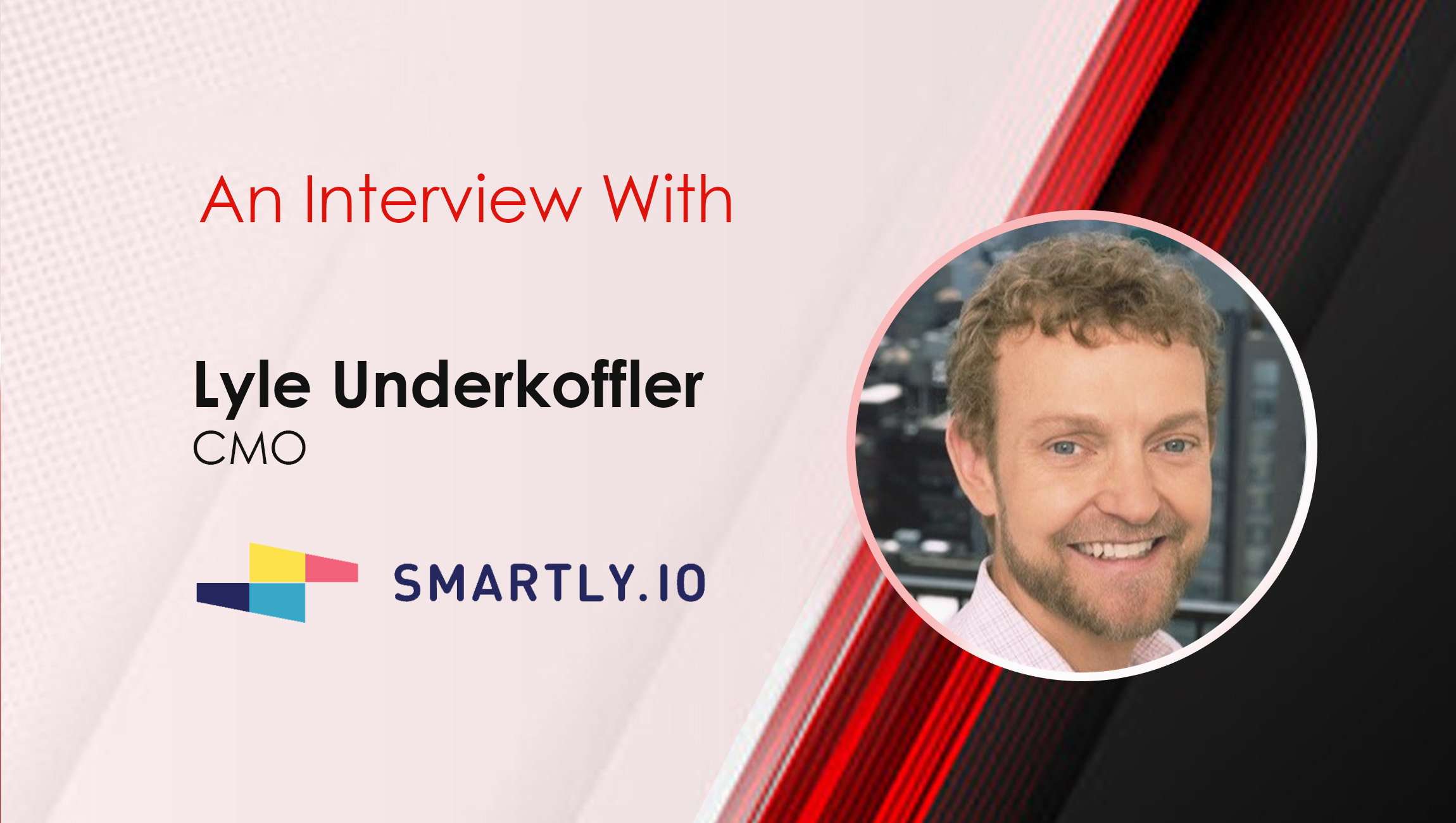Lyle Underkoffler, CMO at Smartly.io chats about key shifts in the marketing and advertising segments in this quick catch-up with MarTech Series:
______
Welcome to this 2022 MarTech Series chat, Lyle, tell us about your marketing journey through the years and more about your role at Smartly.io…
Over the last 25 years I’ve gained a wealth of experience across digital marketing, business development, and advertising. Before joining the Smartly.io team, I served as Head of Digital Marketing & eCommerce at Philips, Personal Health. Prior to that role, I held several executive positions in digital marketing and media at companies including Samsung, AMC Networks, IAC, and Disney. Through these positions I’ve built subscription services, scaled mobile games and content studios, mentored early-stage startups, and led world-class product and creative teams. These experiences helped me develop a deep knowledge and understanding of performance marketing and product management.
As someone who’s been on the advertiser side for many years, I’ve seen a lot of the challenges brands are faced with today. I came to Smartly.io to make the shift from brand to SaaS platform as I saw an opportunity to be on the ground floor of helping resolve so many of the challenges and constraints I faced in previous roles. Building off this, my work with Smartly.io is focused heavily on the creation of exceptional user experiences through a balance of creative intelligence and data insights. I work with the Smartly.io team to drive innovative go-to-market strategies and further drive the company’s accelerated business growth trajectory.
With massive shifts in the advertising industry and consumer behavior continuing to pose challenges — from inefficient internal processes to fragmented messaging externally – we are zeroed in on addressing customer and industry needs while helping advertisers reach audiences with more engaging experiences along their digital journey.
Marketing Technology News: MarTech Interview with Martin Hill, Head of Programmatic at Dianomi
We’d love to hear about Smartly.io’s latest enhancements…how is the product shaping up?
To drive business outcomes, it is essential for advertisers from retailers and big-box brands to understand how to crack the code on social media and determine what is important to consumers in the moment. With constant industry changes, dynamic user behavior and further regulation around data privacy, it is no easy feat for retailers to implement ad strategies that address all of this.
With our latest enhancements, we’re helping retailers and brands leverage social media ads in a way that helps drive innovation and increase revenue, tap into new strategies, and improve bottom line results. Our goal is to always provide brands with a competitive edge when it comes to their social media advertising strategies – specifically through new products and tools that break down silos and help advertisers bridge gaps between internal teams. Our retail customers continue to seek out new and authentic ways to engage consumers and they want to be able to test across all touchpoints of the buyer journey. Our latest release is another step in how Smartly.io empowers retailers to do this via technology and automation, underpinned with consumer-first focus.
Marketing Technology News: MarTech Interview with JR Sherman, CEO at RainFocus
How are you seeing social advertising play a more crucial role today?
What I’m seeing is a notion of collapsing the funnel to be more consumer journey specific. In this we are seeing more consistent storytelling across all social touchpoints. We are seeing a shift in advertisers leveraging social as a holistic experience, no longer assuming that the role social advertising plays is all lower funnel.
Consumers are also on a variety of social surfaces these days, so consistency and the way brands show up on the multitude of apps needs to be germane not only to the platform itself but to your brand. If you show up differently across these surfaces, you will be perceived as different, and that’s not always the best for the brand or what’s needed to make impact with social advertising. Social advertising has also created more of an opportunity for brands to be conversational – there’s more back and forth happening between brands and their audiences and the relationship with customers is built over time, not just through the act of transaction.
Social media advertising is increasingly playing a more critical role in brand building. Consumers need to love who you are, not just what you’re trying to sell to them. This is particularly interesting when it comes to influencers and creators. They can be seen as a transaction or medium, rather than a person with a passion. They have the ability to build so much in terms of brand connection and recognition. A good example from my time at Samsung, was when we started working with students to create ‘art’ using new devices. Not only was Samsung getting exposure from these artists showcasing their work on their own social channels, but the company also started hiring these artists and credentialing their work via Samsung’s social channels, branding and more. What came out of this was a unique win-win situation because the company gained a relationship with fantastic talents who weren’t necessarily influencers by job but were sharing the amazing creations they were making with the devices. Samsung ended up with the ability to help these artists build their creator brands while the artists, in turn, helped build the Samsung brand.
Marketing Technology News: MarTech Interview with Sam Chapman, Director of Content Strategy and Brand Experience at Aprimo
Can you talk about a few leading brands that have used social advertising to create impact?
I’ve seen a few brands leveraging social advertising well to create impact. A few that come to mind are Patagonia, Trader Joes and Vans. Retail is a prime space for brands to leverage what’s happening on social to promote and/or support social causes as part of building their overall brand personas with varying audiences.
Patagonia as a brand has impact built-in, not just business impact but also social responsibility, environmental and more. What they’ve done well is leverage that impact on a hyper local level. From community events they sponsor to location accounts, they focus on social at the micro-level to make impact. This can be as simple as events focused on reducing packaging to environmental grants. They’ve also done a great job of using their fans as brand ambassadors and advocates through photography and other kinds of user generated content. By inviting in fans and consumers and promoting the content that these individuals create, the brand treats them as people, not just transactions.
Trader Joes highlights new products via social media exceedingly well. They’re always rotating products in and out and making this a conversation on social to create chatter. They leverage social to seed their products and the authenticity with which they do this pulls people in (and also looks tasty too). Trader Joe’s focuses on what they know their audience/shoppers love and brings them new things that build off that and, in turn, will be exciting. The way they communicate this is always personable and authentic. I also admire how they are selective of the platforms they use for these different messages. They don’t try to be everywhere, but instead they focus on bringing the right message to the right place. They also get stores and store managers involved in these launches, so it’s not just the marketing team, but the Trader Joe’s team in its entirety. By treating it as a community, Trader Joe’s creates a connection with their audience via social channels.
Vans is great at promoting events and using virtual to make physical in many ways. For example, their recent ‘ads for creativity’ campaign celebrates artists and encourages them to make things. They also authentically display the diversity of their consumers reflected back to them, very well. While this is very true to the Vans brand, it’s also something that not everyone is doing well on social. I have a lot of respect for them in how they continue to execute this.
For brands using social ad platforms or social ad channels for the first time, what best practices and pointers would you share?
I would say as a first step, automate across the board. Already this year we’re seeing automation blend into a broader range of processes in both the creation and delivery of social media ads. A lot of advertisers are looking to automation to create their social ads. New tools are letting advertisers more effortlessly generate, launch, and scale social ads, with just a few clicks – making it possible for brands to manage campaigns all in one place to coordinate and optimize creatives across platforms and formats more easily. Automation really makes the work of social advertising not only more efficient but also more fun and interesting. When processes can be streamlined, advertisers can more effectively manage multi-platform campaigns and focus on learning what is working.
This brings me to my next piece of advice – multiplatform investment should be a key part of your social media advertising strategy. Users have gone multiplatform and so should advertisers. Consumer journeys continue to become more complex, so brands need to meet users whenever and wherever they are. This means creating an omnipresent multiplatform social strategy that speaks to consumers at all touchpoints and mindsets along their journey and potential path to purchase.
TikTok’s popularity is also booming. It’s a platform with a unique creative style and it opens advertisers up to a wealth of benefits, from reaching Gen Z audiences more directly to tapping into the popularity and influence of Creators to presenting ads in a way that celebrates authenticity. If you’re not already advertising on TikTok, you should be. They have a wealth of resources, and their partner network is growing to provide even more tools to help advertisers navigate the platform creatively and authentically.
Overall, how do you feel online advertising will shift further through 2022?
What’s going to be important is the shift to respecting consumers on social platforms. It’s going to be about building the relationship with the consumer over time. Advertisers are going to need to look at how this becomes a win-win-win where consumers invite brands in while protecting their identity and, ultimately, those brands that are invited in will win because they’re putting out great advertising. Additionally, the platforms will win because they are engaging consumers in things they care about.
I also see creative becoming the lead force, rather than media. This will be about how to focus your non-working dollars, your assets and stories, to work harder so that the media is more effective. The benefit of these assets is that they are durable meaning they are reusable, retune-able, and more. The focus will need to be on great storytelling to attract an audience to help the media dollars go further.
The balance of advertising dollars and where consumers are is going to be more distributed this year (and beyond) as we see more shifts across platforms like TikTok and other evolving platforms. We’re also seeing a rise of how social can do good. More and more people lean into this notion of freedom of expression and freedom of speech, so how do the social platforms allow for this? It’s a matter of whether advertising can not only just transact but do good and build community on these platforms.
What used to be easy to measure is now going to be distributed across an experience. Engaging in that experience through all touchpoints is going to be the way of successful advertising going forward.
Marketing Technology News: MarTech Interview with Ed Locher, Vice President of Marketing at HG Insights
As adtech becomes more sophisticated, what kind of features will start to become more like must-haves to online marketers/advertisers in your view?
Measurement will change, in fact it is already changing. This notion of data interoperability will be a must have for advertisers. Being able to understand how you perform across platforms and having the data to support that is a way to future-proof strategies and to link to business outcomes. And the capability for measurement across platforms, not just on Instagram or TikTok or Facebook, but across them all will be paramount.
Data-informed decision-making, especially applied to creative will be critical. We need to think about how we can learn in real-time what audiences or consumers are reacting to and then create compelling content to have them go deeper in that interaction. That’s data informed, i.e., the brand is listening, but then you’re also going a step further and creating something with the audience to propel deeper, more interesting engagement.
Lastly, as we see more demands around measurement, creative, media and more, we need to be thinking about how tools become a bit more seamless. The must-have in this case is that anyone can use the tools – not just technical performance marketers or database administrator. Now it’s about surfacing tools that everyday marketers can use. Whether that’s through visually identifying trends or placing media investment or approving a creative brief, it’s mission critical to have tools that become easier to use.
Some last thoughts, takeaways, before we wrap up?
Brands need to think about social not as performance, but brand engagement all the way through performance – delivered via creativity to consumers in a way that only social is able to do. If you don’t think about this as end-to-end and don’t think about it as something that’s compelling creatively, you’ll lose the game.
Social advertising is complex and all the shifts we’re seeing are difficult. We need a cross-functional and cross-disciplined approach to find the right answers. For me, where I’m seeing success is in finding great partners. Sometimes these partners are advertisers, sometimes the brands themselves or even the social platforms. They’re all coming together to solve complex problems. This doesn’t happen with a brand on its own – it happens together and finding these solutions between brand partnerships is how I believe much of the future of social advertising will emerge.

Smartly.io automates every step of social advertising to unlock greater performance and creativity.
Lyle Underkoffler is CMO at Smartly.io
Missed The Latest Episode of The SalesStar Podcast? Have a quick listen here!
Episode 125: Sell without Selling Out – A Conversation with Andy Paul
Episode 124: Improving the Online Buying Journey with David Greenberg, CMO at Conversica
Episode 123: B2B Revenue Tricks And Best Practices with Jamie Bertasi – President and Chief Operating Officer at Totango











